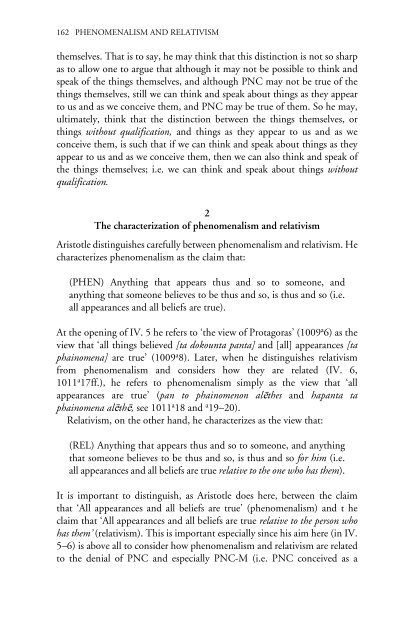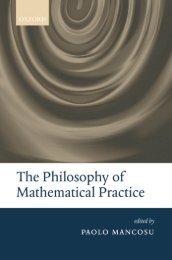- Page 2 and 3:
Routledge Philosophy Guide Book to<
- Page 4 and 5:
Routledge Philosophy Guide Book to<
- Page 6 and 7:
CONTENTSACKNOWLEDGEMENTS x1 <strong
- Page 8 and 9:
5 Is PNC Transcendental, i.e. is It
- Page 10 and 11:
ix9 The Ultimate Cause of Change, a
- Page 12 and 13:
1ARISTOTLE’S METAPHYSICS1What is
- Page 14 and 15:
ARISTOTLE’S METAPHYSICS 3apparent
- Page 16 and 17:
ARISTOTLE’S METAPHYSICS 5other an
- Page 18 and 19:
ARISTOTLE’S METAPHYSICS 7previous
- Page 20 and 21:
ARISTOTLE’S METAPHYSICS 9question
- Page 22 and 23:
ARISTOTLE’S METAPHYSICS 11distinc
- Page 24 and 25:
properties, i.e. into things and th
- Page 26 and 27:
ARISTOTLE’S METAPHYSICS 15thinkin
- Page 28 and 29:
ARISTOTLE’S METAPHYSICS 17Quine
- Page 30 and 31:
ARISTOTLE’S METAPHYSICS 19why thi
- Page 32 and 33:
ARISTOTLE’S METAPHYSICS 21right q
- Page 34 and 35:
2METAPHYSICS AS THE SCIENCE OFTHE U
- Page 36 and 37:
THE ULTIMATE EXPLANATIONS OF ALL TH
- Page 38 and 39:
THE ULTIMATE EXPLANATIONS OF ALL TH
- Page 40 and 41:
THE ULTIMATE EXPLANATIONS OF ALL TH
- Page 42 and 43:
THE ULTIMATE EXPLANATIONS OF ALL TH
- Page 44 and 45:
THE ULTIMATE EXPLANATIONS OF ALL TH
- Page 46 and 47:
THE ULTIMATE EXPLANATIONS OF ALL TH
- Page 48 and 49:
THE ULTIMATE EXPLANATIONS OF ALL TH
- Page 50 and 51:
THE ULTIMATE EXPLANATIONS OF ALL TH
- Page 52 and 53:
THE ULTIMATE EXPLANATIONS OF ALL TH
- Page 54 and 55:
THE ULTIMATE EXPLANATIONS OF ALL TH
- Page 56 and 57:
THE ULTIMATE EXPLANATIONS OF ALL TH
- Page 58 and 59:
THE ULTIMATE EXPLANATIONS OF ALL TH
- Page 60 and 61:
THE ULTIMATE EXPLANATIONS OF ALL TH
- Page 62 and 63:
THE ULTIMATE EXPLANATIONS OF ALL TH
- Page 64 and 65:
THE ULTIMATE EXPLANATIONS OF ALL TH
- Page 66 and 67:
THE ULTIMATE EXPLANATIONS OF ALL TH
- Page 68 and 69:
THE ULTIMATE EXPLANATIONS OF ALL TH
- Page 70 and 71:
THE ULTIMATE EXPLANATIONS OF ALL TH
- Page 72 and 73:
THE ULTIMATE EXPLANATIONS OF ALL TH
- Page 74 and 75:
THE ULTIMATE EXPLANATIONS OF ALL TH
- Page 76:
ARISTOTLE’S METHOD IN METAPHYSICS
- Page 79 and 80:
68 ARISTOTLE’S METHOD IN METAPHYS
- Page 81 and 82:
70 ARISTOTLE’S METHOD IN METAPHYS
- Page 83 and 84:
72 ARISTOTLE’S METHOD IN METAPHYS
- Page 85 and 86:
74 ARISTOTLE’S METHOD IN METAPHYS
- Page 87 and 88:
76 ARISTOTLE’S METHOD IN METAPHYS
- Page 89 and 90:
78 ARISTOTLE’S METHOD IN METAPHYS
- Page 91 and 92:
80 ARISTOTLE’S METHOD IN METAPHYS
- Page 93 and 94:
82 ARISTOTLE’S METHOD IN METAPHYS
- Page 95 and 96:
84 ARISTOTLE’S METHOD IN METAPHYS
- Page 97 and 98:
86 ARISTOTLE’S METHOD IN METAPHYS
- Page 99 and 100:
88 ARISTOTLE’S METHOD IN METAPHYS
- Page 101 and 102:
4METAPHYSICS AS THE SCIENCE OFBEING
- Page 103 and 104:
92 BEING QUA BEING AND PRIMARY BEIN
- Page 105 and 106:
94 BEING QUA BEING AND PRIMARY BEIN
- Page 107 and 108:
96 BEING QUA BEING AND PRIMARY BEIN
- Page 109 and 110:
98 BEING QUA BEING AND PRIMARY BEIN
- Page 111 and 112:
100 BEING QUA BEING AND PRIMARY BEI
- Page 113 and 114:
102 BEING QUA BEING AND PRIMARY BEI
- Page 115 and 116:
104 BEING QUA BEING AND PRIMARY BEI
- Page 117 and 118:
106 BEING QUA BEING AND PRIMARY BEI
- Page 119 and 120:
108 BEING QUA BEING AND PRIMARY BEI
- Page 121 and 122: 110 BEING QUA BEING AND PRIMARY BEI
- Page 123 and 124: 112 BEING QUA BEING AND PRIMARY BEI
- Page 125 and 126: 114 BEING QUA BEING AND PRIMARY BEI
- Page 127 and 128: 116 BEING QUA BEING AND PRIMARY BEI
- Page 129 and 130: 118 BEING QUA BEING AND PRIMARY BEI
- Page 131 and 132: 120 BEING QUA BEING AND PRIMARY BEI
- Page 133 and 134: 5THE DEFENCE OF THE PRINCIPLEOF NON
- Page 135 and 136: 124 THE DEFENCE OF PNCwill evidentl
- Page 137 and 138: 126 THE DEFENCE OF PNC2Aris
- Page 139 and 140: 128 THE DEFENCE OF PNCthat PNC must
- Page 141 and 142: 130 THE DEFENCE OF PNCsuppose that
- Page 143 and 144: 132 THE DEFENCE OF PNCcircular and
- Page 145 and 146: 134 THE DEFENCE OF PNCWe may note t
- Page 147 and 148: 136 THE DEFENCE OF PNCSomething cru
- Page 149 and 150: 138 THE DEFENCE OF PNCPNC is a tran
- Page 151 and 152: 140 THE DEFENCE OF PNCin this way d
- Page 153 and 154: 142 THE DEFENCE OF PNCdepends on so
- Page 155 and 156: 144 THE DEFENCE OF PNCsay nothing a
- Page 157 and 158: 146 THE DEFENCE OF PNCthing in one
- Page 159 and 160: 148 THE DEFENCE OF PNCPerhaps this
- Page 161 and 162: 150 THE DEFENCE OF PNCapparently, t
- Page 163 and 164: 152 THE DEFENCE OF PNCthere is a pr
- Page 165 and 166: 154 THE DEFENCE OF PNCview that all
- Page 167 and 168: 156 THE DEFENCE OF PNCFor example,
- Page 169 and 170: 158 PHENOMENALISM AND RELATIVISMkno
- Page 171: 160 PHENOMENALISM AND RELATIVISMthi
- Page 175 and 176: 164 PHENOMENALISM AND RELATIVISM2.
- Page 177 and 178: 166 PHENOMENALISM AND RELATIVISMsuc
- Page 179 and 180: 168 PHENOMENALISM AND RELATIVISMWe
- Page 181 and 182: 170 PHENOMENALISM AND RELATIVISMrig
- Page 183 and 184: 172 PHENOMENALISM AND RELATIVISMthe
- Page 185 and 186: 174 PHENOMENALISM AND RELATIVISMtim
- Page 187 and 188: 176 PHENOMENALISM AND RELATIVISMarg
- Page 189 and 190: 178 PHENOMENALISM AND RELATIVISMAs
- Page 191 and 192: 180 PHENOMENALISM AND RELATIVISMsou
- Page 193 and 194: 182 PHENOMENALISM AND RELATIVISMabo
- Page 195 and 196: 184 PHENOMENALISM AND RELATIVISMthe
- Page 197 and 198: 186 PHENOMENALISM AND RELATIVISMwhi
- Page 199 and 200: 188 PHENOMENALISM AND RELATIVISMthe
- Page 201 and 202: 7THE SEARCH FOR PRIMARY BEING(Book
- Page 203 and 204: 192 THE SEARCH FOR PRIMARY BEINGThe
- Page 205 and 206: 194 THE SEARCH FOR PRIMARY BEINGSo
- Page 207 and 208: 196 THE SEARCH FOR PRIMARY BEINGtha
- Page 209 and 210: 198 THE SEARCH FOR PRIMARY BEINGPri
- Page 211 and 212: 200 THE SEARCH FOR PRIMARY BEING4Pr
- Page 213 and 214: 202 THE SEARCH FOR PRIMARY BEINGadd
- Page 215 and 216: 204 THE SEARCH FOR PRIMARY BEINGQ.
- Page 217 and 218: 206 THE SEARCH FOR PRIMARY BEINGous
- Page 219 and 220: 208 THE SEARCH FOR PRIMARY BEINGWe
- Page 221 and 222: 210 THE SEARCH FOR PRIMARY BEINGwhi
- Page 223 and 224:
212 THE SEARCH FOR PRIMARY BEINGthe
- Page 225 and 226:
214 THE SEARCH FOR PRIMARY BEINGant
- Page 227 and 228:
216 THE SEARCH FOR PRIMARY BEINGmea
- Page 229 and 230:
218 THE SEARCH FOR PRIMARY BEINGBut
- Page 231 and 232:
220 THE SEARCH FOR PRIMARY BEINGSo
- Page 233 and 234:
222 THE SEARCH FOR PRIMARY BEINGhe
- Page 235 and 236:
224 THE SEARCH FOR PRIMARY BEINGbei
- Page 237 and 238:
226 THE SEARCH FOR PRIMARY BEINGabs
- Page 239 and 240:
228 THE SEARCH FOR PRIMARY BEINGof
- Page 241 and 242:
230 THE SEARCH FOR PRIMARY BEINGAlt
- Page 243 and 244:
232 THE SEARCH FOR PRIMARY BEINGThi
- Page 245 and 246:
234 THE SEARCH FOR PRIMARY BEINGIt
- Page 247 and 248:
236 THE SEARCH FOR PRIMARY BEINGthe
- Page 249 and 250:
238 THE SEARCH FOR PRIMARY BEINGtha
- Page 251 and 252:
240 THE SEARCH FOR PRIMARY BEINGthi
- Page 253 and 254:
242 THE SEARCH FOR PRIMARY BEINGx,
- Page 255 and 256:
244 THE SEARCH FOR PRIMARY BEINGuni
- Page 257 and 258:
246 THE SEARCH FOR PRIMARY BEINGon
- Page 259 and 260:
248 THE SEARCH FOR PRIMARY BEINGAlt
- Page 261 and 262:
250 THE SEARCH FOR PRIMARY BEINGden
- Page 263 and 264:
252 THE SEARCH FOR PRIMARY BEINGThi
- Page 265 and 266:
254 THE SEARCH FOR PRIMARY BEINGeme
- Page 267 and 268:
256 THE SEARCH FOR PRIMARY BEINGand
- Page 269 and 270:
258 THE SEARCH FOR PRIMARY BEINGsay
- Page 271 and 272:
8THE ULTIMATE CAUSE OFCHANGE: GOD(B
- Page 273 and 274:
262 THE ULTIMATE CAUSE OF CHANGE: G
- Page 275 and 276:
264 THE ULTIMATE CAUSE OF CHANGE: G
- Page 277 and 278:
266 THE ULTIMATE CAUSE OF CHANGE: G
- Page 279 and 280:
268 THE ULTIMATE CAUSE OF CHANGE: G
- Page 281 and 282:
270 THE ULTIMATE CAUSE OF CHANGE: G
- Page 283 and 284:
272 THE ULTIMATE CAUSE OF CHANGE: G
- Page 285 and 286:
274 THE ULTIMATE CAUSE OF CHANGE: G
- Page 287 and 288:
276 THE ULTIMATE CAUSE OF CHANGE: G
- Page 289 and 290:
278 THE ULTIMATE CAUSE OF CHANGE: G
- Page 291 and 292:
280 THE ULTIMATE CAUSE OF CHANGE: G
- Page 293 and 294:
282 THE ULTIMATE CAUSE OF CHANGE: G
- Page 295 and 296:
284 THE ULTIMATE CAUSE OF CHANGE: G
- Page 297 and 298:
286 THE ULTIMATE CAUSE OF CHANGE: G
- Page 299 and 300:
288 THE ULTIMATE CAUSE OF CHANGE: G
- Page 301 and 302:
290 THE ULTIMATE CAUSE OF CHANGE: G
- Page 303 and 304:
292 THE ULTIMATE CAUSE OF CHANGE: G
- Page 305 and 306:
294 THE ULTIMATE CAUSE OF CHANGE: G
- Page 307 and 308:
296 THE ULTIMATE CAUSE OF CHANGE: G
- Page 309 and 310:
9THE CRITICISM OF PLATO’STHEORY O
- Page 311 and 312:
300 CRITICISM OF PLATO’S THEORY O
- Page 313 and 314:
302 CRITICISM OF PLATO’S THEORY O
- Page 315 and 316:
304 CRITICISM OF PLATO’S THEORY O
- Page 317 and 318:
306 CRITICISM OF PLATO’S THEORY O
- Page 319 and 320:
308 CRITICISM OF PLATO’S THEORY O
- Page 321 and 322:
310 CRITICISM OF PLATO’S THEORY O
- Page 323 and 324:
312 CRITICISM OF PLATO’S THEORY O
- Page 325 and 326:
314 CRITICISM OF PLATO’S THEORY O
- Page 327 and 328:
316 CRITICISM OF PLATO’S THEORY O
- Page 329 and 330:
318 CRITICISM OF PLATO’S THEORY O
- Page 331 and 332:
320 CRITICISM OF PLATO’S THEORY O
- Page 333 and 334:
322 CRITICISM OF PLATO’S THEORY O
- Page 335 and 336:
324 CRITICISM OF PLATO’S THEORY O
- Page 337 and 338:
326 CRITICISM OF PLATO’S THEORY O
- Page 339 and 340:
328 CRITICISM OF PLATO’S THEORY O
- Page 341 and 342:
330 CRITICISM OF PLATO’S THEORY O
- Page 343 and 344:
332 CRITICISM OF PLATO’S THEORY O
- Page 345 and 346:
CONCLUSIONWhat would we have to do
- Page 347 and 348:
FURTHER READINGOn Chapter 1For gene
- Page 349 and 350:
BlBLIOGRAPHYTranslations of the Met
- Page 351 and 352:
340 BIBLIOGRAPHYFine, K. 1995. ‘O
- Page 353 and 354:
342 BIBLIOGRAPHYPriest, G. 1998.
- Page 355 and 356:
INDEXGreek terms (and titles of wor
- Page 357 and 358:
346 INDEXmethod 63ffmonism 5motion






